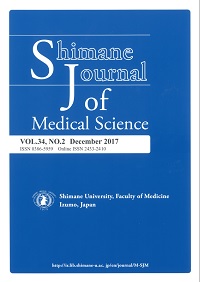Shimane University Faculty of Medicine
ISSN :0386-5959(in print)
ISSN :2433-2410(online)


These article are licensed under a Creative Commons Attribution-NonCommercial-NoDerivatives 4.0 International License.
number of downloads : ?
Use this link to cite this item : https://ir.lib.shimane-u.ac.jp/49609
Shimane Journal of Medical Science 37 1
2020-03 発行
Relationship of Cystatin C With the Pathophysiology of CNS Diseases
Description
Cystatin C (cysC) is a low molecular weight basic protein(13kDa) belonging to the cystatin superfamily. It inhibits lysosomal cysteine proteases, such as cathepsins B, H, and L, and is present in all human body fluids at physiologically significant concentrations, being particularly abundant in the cerebrospinal fluid. While cysC Leu68Gln variant is known to induce amyloid deposition in cerebral arterioles, resulting in cerebral amyloid angiopathy (CAA) with amyloidosis, Icelandic type(HCHWA-I), wild-type cysC deposition is also observed in solitary cerebral amyloid angiopathy involving amyloid β protein( Aβ), which may progress to cerebral hemorrhage or white matter disturbance. Wildtype cysC also tends to form dimers and accelerates the amyloidogenicity of Aβ under certain conditions in vitro. The high cysC concentration in cerebrospinal fluid(CSF) is thought to be important for modulating cysteine protease activities to maintain central nervous system(CNS) homeostasis. In inflammatory neurological diseases (INDs), leptomeningeal metastasis (LM)and some in amyotrophic lateral sclerosis (ALS), low cyC levels are accompanied with high activities of cathepsins in the CNS. CysC is localized in the cytoplasm of every cell type in the CNS and is thought to be involved in the nerurodegenerative processes. Analysis of genetic polymorphism indicated that the G/A variation at position 73 may be a risk factor for Alzheimer’s disease (AD) onset. Our recent findings revealed that cysC might be involved in the degenerative processes of spinal motor neurons in ALS. CysC is an interesting protein for further investigation because it is involved in inflammation and cell death processes by means of two aspects of its amyloidogenicity and lysosomal cysteine protease. This article reviews the relationship of cysC with pathophysiology of CNS diseases, including our clinical and research findings.
About This Article
Rights
Faculty of Medicine, Shimane University
Other Article
PP. 13 - 20
